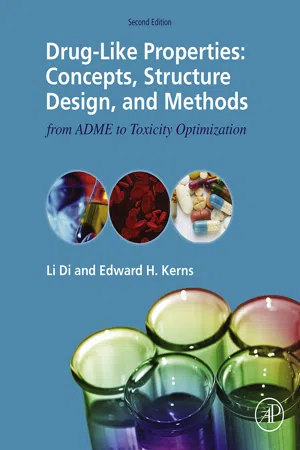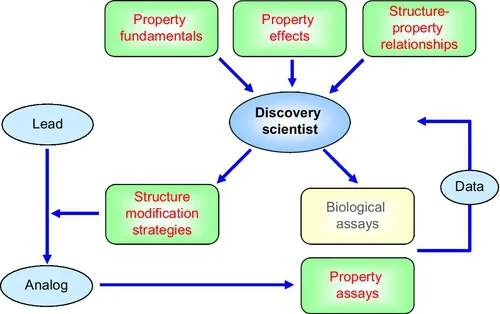
Drug-Like Properties
Concepts, Structure Design and Methods from ADME to Toxicity Optimization
- 580 pages
- English
- ePUB (mobile friendly)
- Available on iOS & Android
Drug-Like Properties
Concepts, Structure Design and Methods from ADME to Toxicity Optimization
About this book
Of the thousands of novel compounds that a drug discovery project team invents and that bind to the therapeutic target, only a fraction have sufficient ADME (absorption, distribution, metabolism, elimination) properties, and acceptable toxicology properties, to become a drug product that will successfully complete human Phase I clinical trials. Drug-Like Properties: Concepts, Structure Design and Methods from ADME to Toxicity Optimization, Second Edition, provides scientists and students the background and tools to understand, discover, and develop optimal clinical candidates. This valuable resource explores physiochemical properties, including solubility and permeability, before exploring how compounds are absorbed, distributed, and metabolized safely and stably. Review chapters provide context and underscore the importance of key concepts such as pharmacokinetics, toxicity, the blood-brain barrier, diagnosing drug limitations, prodrugs, and formulation. Building on those foundations, this thoroughly updated revision covers a wide variety of current methods for the screening (high throughput), diagnosis (medium throughput) and in-depth (low throughput) analysis of drug properties for process and product improvement. From conducting key assays for interpretation and structural analysis, the reader learns to implement modification methods and improve each ADME property.Through valuable case studies, structure-property relationship descriptions, and structure modification strategies, Drug-Like Properties, Second Edition, offers tools and methods for ADME/Tox scientists through all aspects of drug research, discovery, design, development, and optimization.- Provides a comprehensive and valuable working handbook for scientists and students in medicinal chemistry- Includes expanded coverage of pharmacokinetics fundamentals and effects- Contains updates throughout, including the authors' recent work in the importance of solubility in drug development; new and currently used property methods, with a reduction of seldom-used methods; and exploration of computational modeling methods
Frequently asked questions
- Essential is ideal for learners and professionals who enjoy exploring a wide range of subjects. Access the Essential Library with 800,000+ trusted titles and best-sellers across business, personal growth, and the humanities. Includes unlimited reading time and Standard Read Aloud voice.
- Complete: Perfect for advanced learners and researchers needing full, unrestricted access. Unlock 1.4M+ books across hundreds of subjects, including academic and specialized titles. The Complete Plan also includes advanced features like Premium Read Aloud and Research Assistant.
Please note we cannot support devices running on iOS 13 and Android 7 or earlier. Learn more about using the app.
Information
Introduction
Abstract
1.1 Drug-like Properties in Drug Discovery
1.2 Purpose of This Book

Problems
Table of contents
- Cover image
- Title page
- Table of Contents
- Copyright
- Dedication
- Preface
- Chapter 1: Introduction
- Chapter 2: Benefits of Property Assessment and Good Drug-Like Properties
- Chapter 3: In Vivo Environments Affect Drug Exposure
- Chapter 4: Prediction Rules for Rapid Property Profiling from Structure
- Chapter 5: Lipophilicity
- Chapter 6: pKa
- Chapter 7: Solubility
- Chapter 8: Permeability
- Chapter 9: Transporters
- Chapter 10: Blood-Brain Barrier
- Chapter 11: Metabolic Stability
- Chapter 12: Plasma Stability
- Chapter 13: Solution Stability
- Chapter 14: Plasma and Tissue Binding
- Chapter 15: Cytochrome P450 Inhibition
- Chapter 16: hERG Blocking
- Chapter 17: Toxicity
- Chapter 18: Integrity and Purity
- Chapter 19: Pharmacokinetics
- Chapter 20: Lead Properties
- Chapter 21: Strategies for Integrating Drug-Like Properties into Drug Discovery
- Chapter 22: Methods for Profiling Drug-Like Properties: General Concepts
- Chapter 23: Lipophilicity Methods
- Chapter 24: pKa Methods
- Chapter 25: Solubility Methods
- Chapter 26: Permeability Methods
- Chapter 27: Transporter Methods
- Chapter 28: Blood-Brain Barrier Methods
- Chapter 29: Metabolic Stability Methods
- Chapter 30: Plasma Stability Methods
- Chapter 31: Solution Stability Methods
- Chapter 32: CYP Inhibition Methods
- Chapter 33: Plasma and Tissue Binding Methods
- Chapter 34: hERG Methods
- Chapter 35: Toxicity Methods
- Chapter 36: Integrity and Purity Methods
- Chapter 37: Pharmacokinetic Methods
- Chapter 38: Diagnosing and Improving Pharmacokinetic Performance
- Chapter 39: Prodrugs
- Chapter 40: Effects of Properties on Biological Assays
- Chapter 41: Formulation
- Appendix I: Answers to Chapter Problems
- Appendix II: General Reference Books
- Appendix III: Glossary
- Index